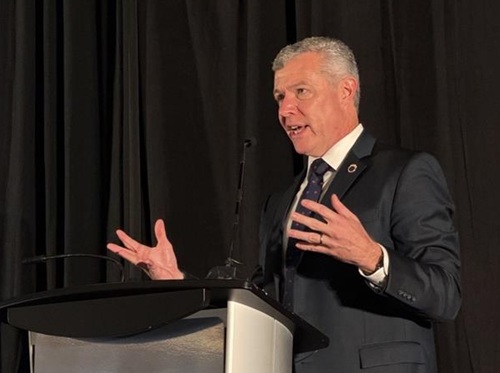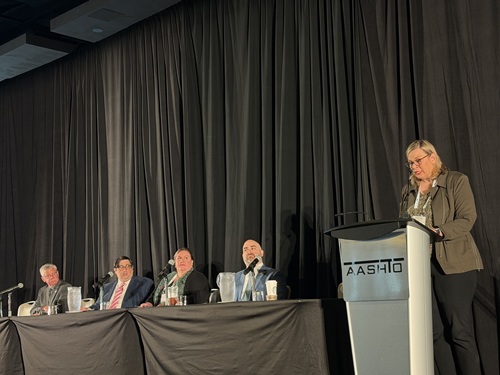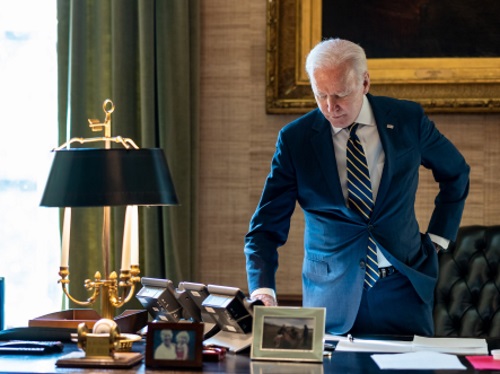On March 28, President Biden (seen above) unveiled the federal government’s proposed budget for fiscal year 2023 starting on October 1.
[Above photo by the White House]
The Biden administration’s proposed budget includes $142.3 billion in total gross budget authority for the U.S. Department of Transportation, an increase of $1.6 billion or 1.1 percent over the enacted level for FY 2022.

That includes an additional $36.8 billion in guaranteed “advanced appropriations” provided via the $1.2 trillion Infrastructure Investment and Jobs Act or IIJA, signed into law in November 2021.
That funding also includes $78.4 billion in Highway Trust Fund contract authority, an increase of $1.6 billion over the FY 2022 enacted level and $27.1 billion in regular appropriations, level with the amount enacted in FY 2022.
In a statement, the USDOT provided a modal breakdown of its proposed FY 2023 total budget authority:
- The Federal Aviation Administration receives $23 billion, a 0.4 percent increase vs. FY 2022.
- The Federal Highway Administration receives $69 billion, a 1.6 percent decrease vs. FY 2022.
- The Federal Transit Administration receives $21 billion, a 3 percent increase vs. FY 2022.
- The Federal Railroad Administration receives $17.9 billion, an 8.1 percent increase vs. FY 2022.
- The National Highway Traffic Safety Administration receives $1.5 billion, a 6.6 percent increase vs. FY 2022.
In addition to the FY 2023 budget, USDOT has unveiled a new FY 2022-2026 Strategic Plan to provide a “roadmap” for how to invest the additional transportation funding provided by the IIJA.

Analysis by the American Association of State Highway and Transportation Officials indicates the proposed FY 2023 budget for USDOT honors full funding levels outlined in the IIJA. As a result, there are no funding changes to IIJA-authorized contract authority programs from the Highway Trust Fund and advance General Fund appropriations for FY 2023.
Unique to the IIJA, advanced appropriations in the bill play a key role within the law’s five-year funding plan, dedicating future revenue to specific transportation programs, which is something not easily undone by Congress.
AASHTO noted that the administration’s proposed budget for FY 2023 does not include any beyond-IIJA General Fund supplements on top of already-authorized funds seen in the last budget cycle, such as the bridge deck-based formula program and earmarked projects.
AASHTO also pointed to several “notable increases” in USDOT’s proposed FY 2023 budget, including:
- $1.5 billion for National Infrastructure Investments, a $725 million increase for the combination of Rebuilding American Infrastructure with Sustainability and Equity or RAISE and megaproject grant programs.
- $111 million for the “Thriving Communities” program within the USDOT’s Office of the Secretary, an $86 million increase.
- $1.2 billion in regular appropriations for the Amtrak Northeast Corridor (a 37 percent increase) plus $1.2 billion in IIJA advance appropriations for a total of $2.4 billion.
- $1.8 billion in regular appropriations for the Amtrak National Network (a 23 percent increase) plus $3.2 billion in IIJA advance appropriations for a total of $5 billion.
- $2.9 billion for FTA Capital Investment Grants (a 26 percent increase).
- A $43 million increase (30 percent) for the USDOT’s Office of the Secretary for salaries and expenses.
AASHTO noted that the 30 percent increase of USDOT salaries and expenses reflects a commitment by the agency to “staff up” to handle increases in discretionary grant programs funding and other initiatives funded by the IIJA.
The administration’s proposed FY 2023 budget also outlines specific funding to help USDOT attain goals laid out in the National Roadway Safety Strategy the agency unveiled in January:
- $3 billion for FHWA’s Highway Safety Improvement Program, which seeks to reduce the number of lives lost on U.S. highways, bridges, and roads.
- $506 million for Federal Motor Carrier Administration safety grants.
- $49.8 million for NHTSA’s Vehicle Safety Research, to study vehicle improvements and other technological advances that can better protect people in a crash and reduce the likelihood of crashes, which includes $18.1 million for Advanced Driver Assistance Systems, $3.1 million for its Heavy Vehicle Safety Technologies Programs, and $11.8 million for Automated Driving Systems research.
 Top Stories
Top Stories
Collaboration Touted at AASHTO’s Third Safety Summit
October 31, 2025 Top Stories
Top Stories

